TABLE A Comparative Summary Statistics for All Wholesale and Retail Trade; Repair of Motor Vehicles and Motorcycles Establishments: Philippines, 2017 and 2016
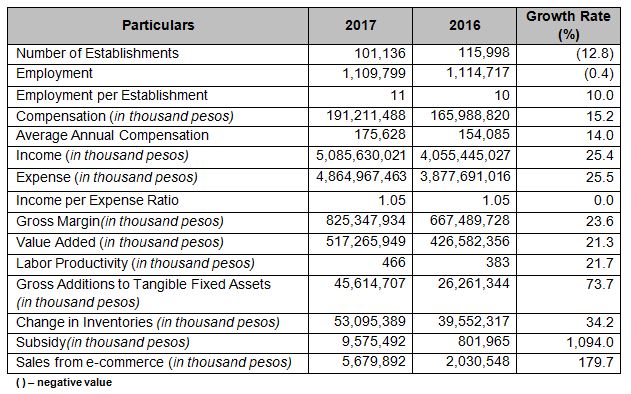
Retail sale of other goods in specialized stores industry has the most number of establishments
The final results of the Annual Survey of Philippine Business and Industry (ASPBI) showed that a total of 101,136 establishments were engaged in wholesale and retail trade; repair of motor vehicles and motorcycles in 2017. This represents a decrease of 12.8 percent compared with the 115,998 establishments in 2016.
Among the industry groups, retail sale of other goods in specialized stores reported the highest share of 30.7 percent to total number of establishments for the sector. This was followed by retail sale of other household equipment in specialized stores with 13.4 percent. Retail sale of food, beverages and tobacco in specialized stores came in third with 8.9 percent.
Figure 1 presents the percentage distribution of the number of establishments for all establishments of the sector by industry group in 2017.
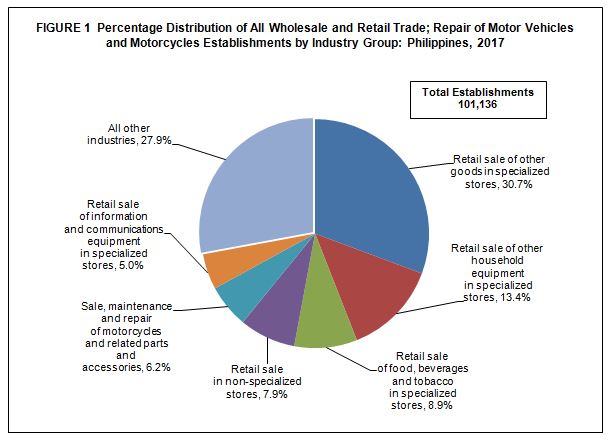
Number of workers declines by 0.4 percent
The total employment for the sector was 1,109,799, a decrease of 0.4 percent compared with the 1,114,717 workers in 2016. Of the total employment, 98.1 percent were paid workers and the rest were working owners and unpaid workers.
The top three industry groups of the sector provided employment to almost half of the total workforce of the sector at 49.9 percent. These were the following:
- Retail sale of other goods in specialized stores, 19.0%
- Retail sale in non-specialized stores, 17.9%
- Retail sale of other household equipment in specialized stores, 13.0%.
Figure 2 shows the distribution of employment for all establishments of the sector by industry group in 2017.
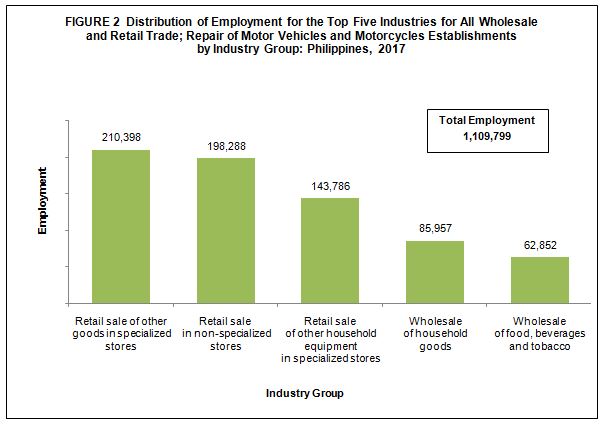
The average number of workers per establishment for the sector was posted at 11, higher by 10.0 percent from the previous year’s record of 10 workers per establishment. Sale of motor vehicles had the highest average of 33 workers per establishment while retail sale of food, beverages and tobacco in specialized stores had the lowest average of six workers per establishment.
Employees of non-specialized wholesale trade receive highest average annual compensation
The total compensation paid by the sector to its employees reached PhP191.2 billion in 2017, which translates to an average annual compensation of PhP175.6 thousand per employee. This amount indicates an increase of 14.0 percent compared with the average annual compensation of PhP154.1 thousand per employee in 2016.
Employees of non-specialized wholesale trade recorded the highest average annual compensation of PhP332.7 thousand per employee. On the other hand, employees of wholesale of agricultural raw materials and live animals received the lowest average annual compensation of PhP113.4 thousand per employee.
Figure 3 shows the average annual compensation of employees for the top five industries of the sector by industry group in 2017.
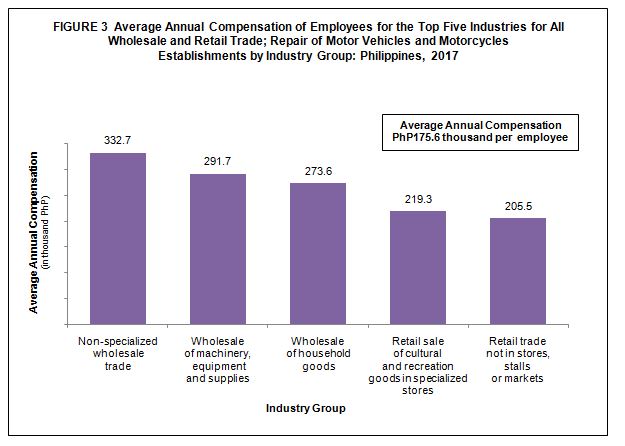
Retail sale in non-specialized stores industry accounts for the largest income and expense
The sector generated a total income of PhP5.1 trillion and incurred a total expense of PhP4.9 trillion in 2017, an annual growth of 25.4 percent and 25.5 percent, respectively, relative to their values in 2016.
The top three industry groups in terms of income and expense for the sector were as follows:
- Retail sale in non-specialized stores with income of PhP916.0 billion (18.0%) and expense of PhP880.8 billion (18.1%)
- Retail sale of other goods in specialized stores with PhP584.6 billion (11.5%) returns and an expense of PhP570.0 billion (11.7%)
- Wholesale of household goods with PhP548.4 billion proceeds (10.8%) and PhP514.9 billion expense (10.6%)
On the other hand, non-specialized wholesale trade had the lowest income of PhP5.5 billion (0.1%) and lowest expense of PhP5.2 billion (0.1%).
Figure 4 shows the top five industry groups in terms of income and expense for all establishments of the sector by industry group in 2017.
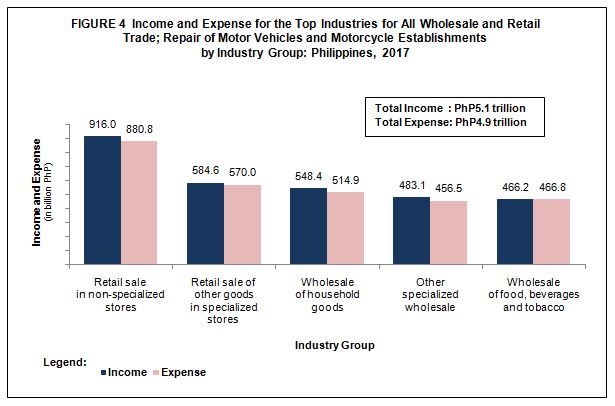
An income per peso expense of 1.05 in 2017 was generated by the sector which was the same as the previous year’s income per peso expense.
Among the industries, maintenance and repair of motor vehicles recorded the highest income per peso expense of 1.22. This was followed by sale, maintenance and repair of motorcycles and related parts and accessories with income per peso expense of 1.11.
Gross margin increases by 23.6 percent
The gross margin generated by the sector amounted to PhP825.3 billion in 2017, an increase of 23.6 percent compared with the PhP667.5 billion gross margin in 2016.
The top three industry groups that contributed 45.6 percent to the total gross margin of the sector were the following:
- Retail sale in non-specialized stores, 17.9%
- Retail sale of other goods in specialized stores,14.3%
- Wholesale of household goods, 13.4%.
Figure 5 shows the distribution of gross margin for the top five industries for all establishments of the sector by industry group in 2017.
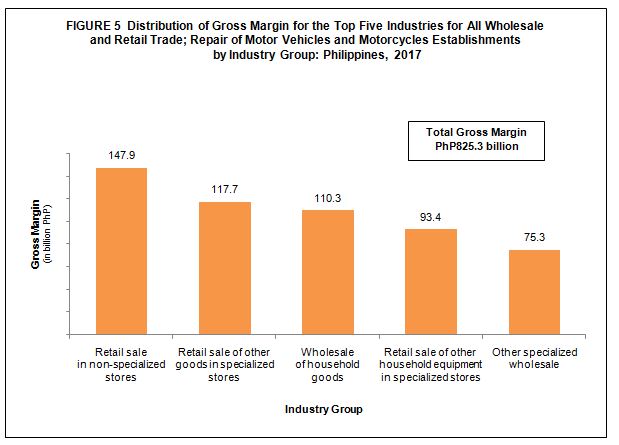
Value added of the sector up by 21.3 percent
The total value added generated by all establishments of the sector in 2017 was estimated at PhP517.3 billion, higher by 21.3 percent than the reported PhP426.6 billion value added in 2016.
By industry group, retail sale in non-specialized stores recorded the highest value added of PhP84.1 billion (16.3%) while non-specialized wholesale generated the lowest, PhP745.2 million (0.1%).
Other specialized wholesale industry records the highest labor productivity
Labor productivity, which is the ratio of value added to total employment, was recorded at PhP466.0 thousand per worker. This represents an increase of 21.7 percent compared with the PhP383.0 thousand labor productivity in 2016.
Among the industry groups, other specialized wholesale recorded the highest labor productivity of PhP935.4 thousand per worker while retail sale of food, beverages and tobacco in specialized stores generated the lowest at PhP253.5 thousand per worker.
Figure 6 shows the distribution of labor productivity for the five leading industries for all establishments of the sector by industry group in 2017.
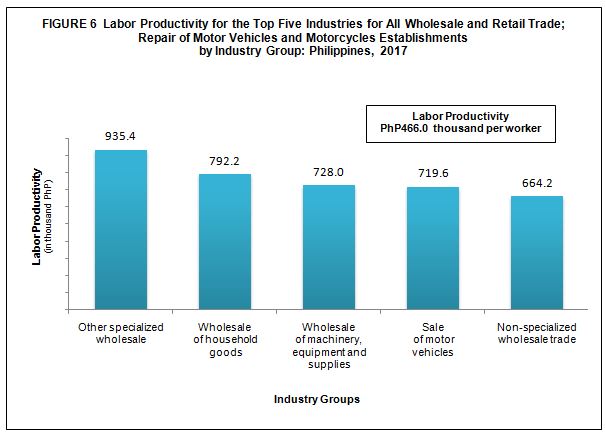
Gross additions to tangible fixed assets accrues to PhP45.6 billion
The sector acquired a total gross additions to tangible fixed assets (capital expenditures less sale of fixed assets) in 2017 of PhP45.6 billion, higher by 73.7 percent than the PhP26.3 billion gross additions to tangible fixed assets in 2016.
Among the industry groups, retail sale in non-specialized stores acquired the highest gross additions to tangible fixed assets at 19.3 percent while non-specialized wholesale trade had the least at 0.003 percent.
Total change in inventories amounts to PhP53.1 billion
Total change in inventories, computed as ending less beginning inventory, for the sector amounted to PhP53.1 billion in 2017. Compared with the total change in inventories of PhP39.6 billion in 2016, this figure increased by 34.2 percent.
The industry groups with the highest change in inventories were the following:
- Retail sale of automotive fuel in specialized stores, 37.1%
- Other specialized wholesale, 25.7%
- Wholesale of household goods, 25.3%
Subsidies received from the government increase to PhP9.6 billion
Subsidies are special grants received from the government in the form of financial assistance or tax exemption or tax privilege to aid and develop an industry.
Total subsidies received from the government in 2017 amounted to PhP9.6 billion, higher than PhP802.0 million subsidies in the previous year.
In 2017, only two industry groups were provided with subsidies. These were wholesale of food, beverages and tobacco; and wholesale of agricultural raw materials and live animals with PhP8.2 billion and PhP1.4 billion subsidies, respectively.
Retail trade not in stores, stalls or markets industry accounts for 77.5 percent of e-commerce sales
Sales from e-commerce transactions recorded for the sector in 2017 amounted to PhP5.7 billion, an increase of 179.7 percent compared with the PhP2.0 billion sales in 2016.
Among the industry groups, only four had e-commerce sales of more than a hundred million pesos, namely:
- Retail trade not in stores, stalls or markets, PhP4.4 billion
- Retail sale of other household equipment in specialized stores, PhP652.1 million
- Wholesale of machinery, equipment and supplies, PhP343.4 million
- Retail sale in non-specialized stores, PhP174.2 million
(Sgd.) ROSALINDA P. BAUTISTA
Assistant Secretary
Deputy National Statistician
Sectoral Statistics Office
TECHNICAL NOTES
Introduction
This Special Release presents the final results of the 2017 Annual Survey of Philippine Business and Industry (ASPBI) for all Wholesale and Retail Trade; Repair of Motor Vehicles and Motorcycles establishments (Sector G).
The ASPBI is one of the designated statistical activities of the Philippine Statistics Authority (PSA). Data collected from the survey provide information on the levels, structure, performance, and trends of economic activities of the formal sector in the entire country for the year 2017.
The survey was conducted nationwide in 2018 with the year 2017 as the reference period of data, except for employment which is as of 15 November 2017.
Establishment Data Management System (EDMS) was utilized in the decentralized processing of 2017 ASPBI questionnaires in the provinces as well as in the online accomplishment of questionnaire through the PSA website.
Data are presented by industry group or 3-digit level of the 2009 Philippine Standard Industrial Classification (PSIC) at the national level.
Legal Authority
The conduct of the 2017 ASPBI is authorized under Republic Act 10625 known as the Philippine Statistical Act of 2013, which mandates reorganizing and strengthening of the Philippine Statistical System (PSS), its agencies and instrumentalities.
Scope and Coverage
The 2017 ASPBI covered establishments engaged in 18 economic sectors classified under the 2009 PSIC, namely:
- Agriculture, Forestry and Fishing (A)
- Mining and Quarrying (B)
- Manufacturing (C)
- Electricity, Gas, Steam, and Air Conditioning Supply (D)
- Water Supply; Sewerage, Waste Management and Remediation Activities (E)
- Construction (F)
- Wholesale and Retail Trade; Repair of Motor Vehicles and Motorcycles (G)
- Transportation and Storage (H)
- Accommodation and Food Service Activities (I)
- Information and Communication (J)
- Financial and Insurance Activities (K)
- Real Estate Activities (L)
- Professional, Scientific and Technical Activities (M)
- Administrative and Support Service Activities (N)
- Education (P)
- Human Health and Social Work Activities (Q)
- Arts, Entertainment and Recreation (R)
- Other Service Activities (S)
The survey was confined to the formal sector of the economy, which consists of the following:
- Corporations and partnership
- Cooperatives and foundations
- Single proprietorship with employment of 10 and over
- Single proprietorships with branches
Hence, the 2017 ASPBI covered only the following economic units:
- All establishments with total employment (TE) of 10 or more, and;
- All establishments with TE of less than 10, except those establishments with Legal Organization = 1 (single proprietorship) and Economic Organization = 1 (single establishment), that are engaged in economic activities classified according to the 2009 Philippine Standard Industrial Classification (PSIC).
Frame of Establishments
The frame for the 2017 ASPBI was extracted from the 2017 List of Establishments (LE). The estimated number of establishments in operation in the country in 2017 totaled to 917,582. About 228,112 establishments (24,9%) of the total establishments comprise the establishments frame or are within the scope and coverage of the 2017 ASPBI.
Unit of Enumeration
The unit of enumeration for the 2017 ASPBI is the establishment. An establishment is defined as an economic unit under a single ownership or control which engages in one or predominantly one kind of economic activity at a single fixed location.
Taxonomy of Establishments
An establishment is categorized by its economic organization, legal organization, industrial classification, employment size, and geographic location.
Economic Organization refers to the organizational structure or role of the establishment in the organization. An establishment may be single establishment, branch, establishment and main office with branches elsewhere, main office only, and ancillary unit other than main office.
Legal Organization refers to the legal form of the economic entity which owns the establishment. An establishment may be single proprietorship, partnership, government corporation, stock corporation, non-stock corporation, and cooperative.
Industrial classification of an economic unit was determined by the activity from which it derives its major income or revenue. The 2009 PSIC which was approved for adoption by government agencies and instrumentalities through PSA Resolution No. 01 Series of 2017-158 signed on 14 February 2017 was utilized to classify economic units according to their economic activities.
Size of an establishment is determined by its TE as of a specific date. TE refers to the total number of persons who work in or for the establishment.
This includes paid employees, working owners, unpaid workers and all employees who work full-time or part-time including seasonal workers. Included also are persons on short term leave such as those on sick, vacation or annual leaves and on strike.
Geographic Classification refers to the grouping of establishments by geographic area using the Philippine Standard Geographic Code (PSGC) classification. The PSGC contains the latest updates on the official number of regions, provinces, cities, municipalities, and barangays in the Philippines. The PSGC as of 31 December 2017 was used for the 2017 ASPBI.
Sampling Design
The 2017 ASPBI uses a stratified systematic sampling with 5-digit PSIC serving as industry strata, and employment size as the second stratification variable.
Estimation procedure for Establishments with TE of Less Than 20
a. Non-Certainty Stratum
The estimate of the total of a characteristic  for the non-certainty employment stratum TE less than 20 in the sth industry domain was
for the non-certainty employment stratum TE less than 20 in the sth industry domain was

where:
s denotes the non-certainty employment strata in TE of less than 20
Xsj = value of the jth establishment in non-certainty employment stratum in TE of less than 20 in sth industry domain
j = 1,2,3..., ns establishments
Wsj = weight of the jth establishment in the non-certainty employment stratum of less than 20 in the sth industry domain

Ns = total number of establishments in the non-certainty employment stratum in TE of less than 20 in the sth industry domain
ns = number of sample establishments in the non-certainty employment stratum in TE of less than 20 in sth domain
b. Certainty Stratum
The total of a characteristic (Xc) for the certainty employment stratum in the Cth industry domain was

where:
c denotes the certainty employment strata in TE of less than 20 in the cth industry
xcj = value of the jth establishment in the certainty employment strata in TE of less than 20 in the cth industry domain
j = 1,2,3,..., mc establishments
mc = number of establishments in the certainty employment strata in TE of less than 20 in the cth industry domain
c. Total Estimate for TE of Less Than 20
For all sections except B and C, national level estimates of the total of a characteristic  for the industry domain was obtain by aggregating the estimates for all employment strata (non-certainty and certainty) in the same industry domain,
for the industry domain was obtain by aggregating the estimates for all employment strata (non-certainty and certainty) in the same industry domain,

where d denotes the industry domain.
For establishments with TE of 20 and over, the 18 administrative regions serve as the geographic domains while the 5-digit level of the 2009 PSIC serves as the industry domains.
Estimation Procedure for Establishments with TE of 20 and Over
a. Non-Certainty Stratum (strata of TE 20 to 49 and TE 50 to 99)
Sections A, C, E,FG, H, I, J, K, L, M, N, P, Q, R and S.
The estimate of the total of a characteristic  for the non-certainty employment strata in an industry domain in each region,
for the non-certainty employment strata in an industry domain in each region,

where:
s denotes the non-certainty employment strata in TE of 20 and over
p = 1, 2,..., 18 regions (geographic domains)
xspj = value of the jth establishment in the non-certainty employment strata in TE of 20 and over for an industry domain in each region
j = 1, 2, 3,…, nsp establishments
Wspj = weight of the jth establishment in the non-certainty employment strata in TE of 20 and over for an industry domain in each region

Nsp = total number of establishments in the non-certainty employment strata in TE of 20 and over for an industry domain in each region
nsp = number of sample establishments in the non-certainty employment strata in TE of 20 and over for an industry domain in each region
b. Certainty Stratum (Establishments under the following: Section B and D, ICT core industries, BPM industries, GOCCs and with TE 100 and over)
The estimate of the total of a characteristic  for the certainty employment stratum in an industry domain in each region,
for the certainty employment stratum in an industry domain in each region,

where:
c denotes the certainty employment strata in TE of 20 and over
p = 1, 2,..., 18 regions (geographic domains)
xcpj = value of the jth establishment in the certainty employment strata in TE of 20 and over for an industry domain within each region
j = 1, 2, 3, …, mcp establishments
mcp = number of establishments in the certainty employment strata in TE of 20 and over in an industry domain within each region
c. Total Estimate for TE of 20 and Over
The estimate of the total of a characteristic  for the industry domain in each region (geographic domain) was obtained by aggregating the estimates for all employment strata (non-certainty and certainty) in the same industry domain,
for the industry domain in each region (geographic domain) was obtained by aggregating the estimates for all employment strata (non-certainty and certainty) in the same industry domain,

where dp denotes the industry domains in each region.
National level estimates of the characteristics by industry domain were obtained by aggregating separately the estimates  for the particular industry domain from all the regions.
for the particular industry domain from all the regions.
Weight Adjustment Factor for Non-Response
To account for non-response in the non-certainty strata, the adjustment factor (n/n’) was multiplied with the sampling weight (W) of each of the sampling unit. The sampling weight, defined as N/n, was recomputed as

Thus, the adjusted weight (W’spj) for the non-certainty employment stratum for the industry domain with TE 20-99 was

where:
Nsp = total number of establishments in the non-certainty employment stratum with TE 20-99 for the industry domain within each geographic domain (region)
n’sp = number of responding establishments in the non-certainty employment stratum with TE 20-99 for the industry domain within each geographic domain (region)
Response Rate
Response rate for all Wholesale and Retail Trade; Repair of Motor Vehicles and Motorcycles establishments was 88.64 percent (6,286 out of 7,092 establishments). This included receipts of "good" questionnaires, partially accomplished questionnaires, reports of closed, moved out or out of scope establishments.
Of the total responses, 217 establishments responded online.
Reports of the remaining non-reporting establishments were taken from the financial statements from Securities and Exchange Commission (SEC) and other available data sources. Reports of establishments that were found to be duplicate of another establishment, out-of-scope and out of business in 2017 were not included in the generation of statistical tables.
Limitation of Data
The survey covered only the formal sector of the economy.
Concepts and Definitions of Terms
Change in inventories is equivalent to the value of inventories at the end of the year less the value of inventories at the beginning of the year.
Compensation is the sum of salaries and wages, separation/retirement/terminal pay, gratuities, and payments made by the employer in behalf of the employees such as contribution to SSS/GSIS, ECC, PhilHealth, Pag-ibig, etc.
E-commerce is the selling of products or services over electronic systems such as Internet Protocol-based networks and other computer networks. Electronic Data Interchange (EDI) network, or other on-line system. Excluded are orders received from telephone, facsimile and e-mails.
Establishment is an economic unit under a single ownership and control, i. e. under a single entity, engaged in one or predominantly one kind of economic activity at a single fixed location.
Expense is the cost incurred by the establishment during the year whether paid or payable. This is treated on a consumed basis. Valuation is at purchaser price including taxes and other charges, net of rebates, returns and allowances. Goods and services received by the establishment from other establishments of the same enterprise are valued as though purchased.
Gross additions to tangible fixed assets is equal to capital expenditures less sale of fixed assets, including land.
Income or Revenue is the cash received and receivables for goods/products and by-products sold and services rendered. Valuation is at producer prices (ex-establishment) net of discounts and allowances, including duties and taxes but excluding subsidies.
Inventories are the stock of goods owned by and under the control of the establishment as of a fixed date, regardless of where the stocks are located. Valuation is at current replacement cost in purchaser prices. Replacement cost is the cost of an item in terms of its present price rather than its original cost.
Paid employees are all persons working in the establishment and receiving pay, as well as those working away from the establishment paid by and under the control of the establishment. Included are all employees on sick leave, paid vacation or holiday. Excluded are consultants, home workers, receiving pure commissions only, and workers on indefinite leave.
Salaries and wages are payments in cash or in kind to all employees, prior to deductions for employee’s contributions to SSS/GSIS, withholding tax, etc. Included are total basic pay, overtime pay and other benefits.
Subsidies are special grants in the form of financial assistance or tax exemption or tax privilege given by the government to aid and develop an industry.
Value added is gross output less intermediate input. Gross output for Wholesale and Retail Trade; Repair of Motor Vehicles and Motorcycles sector is the sum of income from service rendered, income from non-industrial service done for others (less rent income from land), sales of goods (less cost of goods sold), grants and donations, other income, capital expenditures of fixed assets produced on own account and change in inventories. Intermediate input is the sum of the following expense items: materials and supplies purchased; fuels, lubricants, oils and greases purchased; electricity purchased, water purchased; industrial services done by others; non-industrial services done by others (less rent expense for land); goods purchased for resale; research and development expense; environmental protection expense; royalty fee; franchise fee and other expense.
